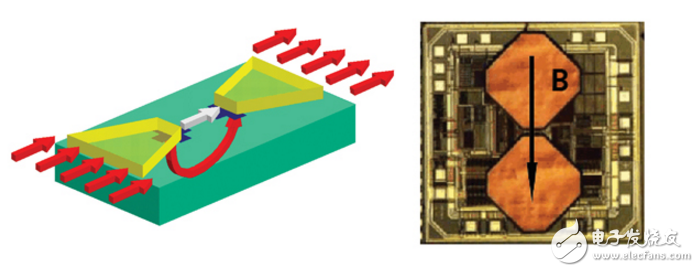
资料下载

新型无接触电流传感器HEV及可再生能源应用
新型无接触电流传感器HEV及可再生能源应用
集成磁集中器(IMC)霍尔效应传感器特别适用于电池电流监测、太阳能逆变器和驱动混合电动汽车和电动车辆牵引电机的功率逆变器。本文解释了IMC电流传感器的设计,它们如何执行,以及它们是如何在这些应用中应用的。
传统上,电流是通过电阻分流器、磁传感器或电流互感器来测量的。虽然电阻分流器是流行的,但磁传感器在系统级提供许多优点。例如,非接触式磁传感器不需要电流导体和传感器之间的电流隔离。电阻式分流器将电能转换为热能,在某些应用中会产生热管理费用和麻烦。磁传感器避免了这些问题。此外,CMOS霍尔效应磁传感器可以集成高级功能以提供高电平输出信号。复杂的磁传感器包含可编程存储器,甚至微控制器逻辑,允许完全定制校准输出。甚至可以实现标准接口,简化与其他电路的通信。
不像电流互感器中的线圈(电流互感器),它测量磁通的时间导数,霍尔效应传感器产生一个与磁通密度本身成比例的信号。这使得测量直流和交流电流实用。

The widespread use of electronics in automotive applications, renewable power conversion (solar and wind power), power supplies, motor control, and overload protection demands that engineers use more effective current measurement techniques. These applications benefit from robust, reliable, isolated, high-speed, and low-cost current measurement techniques provided by IMC sensors.
These novel, contactless current sensors consist of an integrated CMOS Hall effect sensor covered by an additional thin, ferromagnetic layer on its surface. This IMC layer acts as a magnetic flux concentrator, providing a high magnetic gain that increases the sensor‘s signal-to-noise ratio. The sensor is particularly appropriate for DC and AC current measurement. Such measurements are characterized by the need for ohmic isolation, very low insertion loss, fast response, small package size, and low assembly costs. Typically, current sensors are found in applications such as battery current monitoring, solar power inverters, and power inverters that drive traction motors in EVs (electric vehicles), and HEVs (hybrid electric vehicles)。 There is no upper limit to the level of measurable current of IMC sensors, since their output level depends only on the conductor’s size and its distance from the sensor.
声明:本文内容及配图由入驻作者撰写或者入驻合作网站授权转载。文章观点仅代表作者本人,不代表电子发烧友网立场。文章及其配图仅供工程师学习之用,如有内容侵权或者其他违规问题,请联系本站处理。 举报投诉
- 相关下载
- 相关文章





